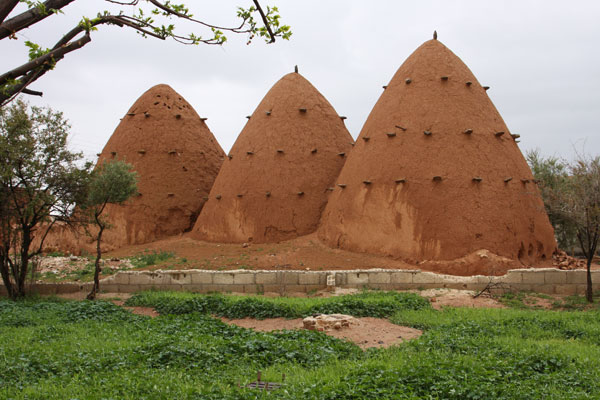Syria travel guide
1 2
Aleppo is the iconic Middle Eastern bazaar city, with an amazing souq (market), an impressive citadel right in the middle, old Mercedes in the streets and friendly people. In its heydays, it was one of the most important trade centres on the Silk Route, but even today you can still shop-till-you-drop for local stuff like olive soap. Rise to the top of the tower in the citadel to get panoramic views of the town and visit a hammam (public bath) or some of the old traditional houses that are open for visitors. The new part of town attracts the young and rich, where they go double dating over tea and apple nargileh (water pipe) in a Starbuck's look-a-like café. A great city that you can keep exploring.
An overgrown and tranquil set of Roman ruins, but nevertheless impressive. The truly remarkable cardo (main street) keeps going for 2 km and is actually longer than the one in Palmyra. Its population was once half a million and the city attracted prominent visitors like Cleopatra. Today, the grassy surroundings make the ruins even more splendid, with blue mountains in the distance, cereal fields all the way up to the stones and herdsmen leading their sheep across the site. With no fences and wild flowers growing on the crumbled stones the place has a refreshing messiness to it.
These adobe huts do look like something from deep Africa. In ancient times, they were used as housing, but today they are merely storeroom and chicken shelters. A few villagers outside Hama still have them clustered next to their more ordinary houses. You have to trespass their courtyard to get a closer look, and it seems at bit random whether the people want to show them to you. Some want a bit of money, but most villagers are friendly and just watchful for their vegetables, making sure you are not stepping on them. You can see the houses on the road from Al-Hamra village to Qasr ibn Warden, a small ruin of a Byzantine sandstone palace in the middle of the plain.
Scattered over a soft hill behind the modern town of Al-Ma'ara is another refreshingly strange site in Syria. A series of abandoned old cities left to nature, sheep and local weekend picnickers. Some sites only have a few monuments, while places like Serjilla have crumbled buildings forming a whole town including a tavern, hammam (bath) and church. It's a tangled adventure to explore the huge area which is partly covered in fields, olive groves and long grass and with side roads going in every direction. Other dead cities are Jerada, Ruweiha and Al-Bara, but it's hard to figure out where one starts and ends.
Hama is a very pleasant city half between Damascus and Aleppo. It was heavily destroyed during the bombardment in 1982 when the military eliminated the illegal Muslim Brotherhood movement. The remains of the old town, though still very charming, can seem as an insult to old towns in Syria since it's just a couple of winding lanes. The gorgeous Orontes River flows straight through the city with clear water and green banks, where squeaking old wooden water wheels (norias) lift water up into the aqueducts. It's a nice base to explore the surrounding countryside, like Apamea and the Beehive house villages.
Travellers like the castle of Krak Des Chevaliers. It's a real fortress placed high on a hill with double walls, round watchtowers and everything. It was originally built in 1031 by a local emir, but invaded by the crusaders in the tenth century, who made it an important stronghold on the route to the Holy Land. During that time, it was extended with an outer wall which made it impenetrable. In the end, the castle got sieged by Mamluk forces in 1271, and the outnumbered crusaders withdrew and left the castle to the Mamluk sultan. They continued the enforcement of the castle in their oriental style, so today it's a big mix of everything.
Try something different in Syria, go to the Mediterranean coast. As a modern and busy sea port, Lattakia has a different feel and look compared with places back in the lush mountains and the dry plain further east. The city's wealth is shown by tree-lined boulevards and flashy new apartment buildings kept by foreign maids. Small beaches punctuate the else rocky shore, which is sadly littered with the usual plastic rubbish, and the corniche offers shady cafes and beautiful view over the Mediterranean Sea - and construction sites. You can make the journey from Aleppo by train, a pleasant scenic ride without being too spectacular. Go there to get the full picture of Syria.
Dramatically located high on an outcrop lies the Monastery of Mar Musa. With its back to the protective mountains and with grand views over the dry empty plain below, it's a place of serenity. In the early 1980s, the abandoned monastery got resurrected with the help of father Paolo, a very friendly and charismatic priest from Italy, who still runs the monastery along with a handful of Syrians and international disciples. Travellers are welcome no matter how long they stay, though a day visit will hardly make any sense. Stay rather for a few nights to experience the place and atmosphere - and relax, it's not as New Age as it sounds. Visitors are expected to join in on the daily tasks and the stay as well as the food is free but a donation will be appreciated.
This set of marvellous ruins of an ancient city is the icon of Syria. The place started out as an oasis town in the desert, but became a mandatory stop on the flourishing silk route. The city grew rich and powerful and even managed to become a "free city" within the Roman Empire. Then queen Zenobia came to power and rebelled against Rome. She managed to beat up some Roman forces and invade the whole of Syria, Palestine and Egypt, before the glorious days were over and in 271 AD Palmyra was again under Roman control. Even today, it's easy to imagine how impressive the city must have been for visitors. In typical Syrian style, the site is informal with no entrance (except for the Temple of Bel), fences or explanations but it only adds to the magic of the place.
Well aware that people hardly qualify as a place, we list them anyway for they make the country what it is. Many visitors' finest memory of Syria is the people, for they are extremely friendly and welcoming. You are constantly met with courtesy and curiosity, and of course endless invitations for tea. If you look a bit lost, strangers will take you by the hand and lead you to your destination. A shy "al-salaam alaykum" and a smile will open many doors and get you a lot closer to the soul of Syria than any visit to a ruin will.
1 2













